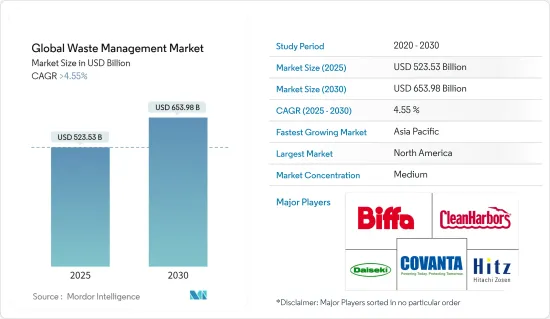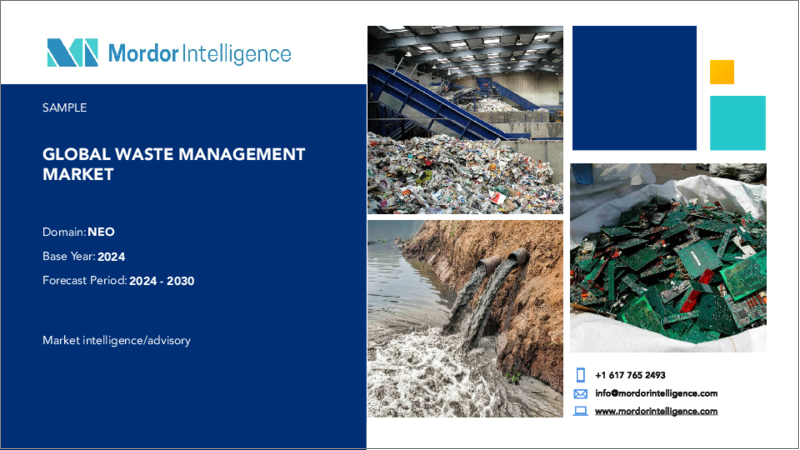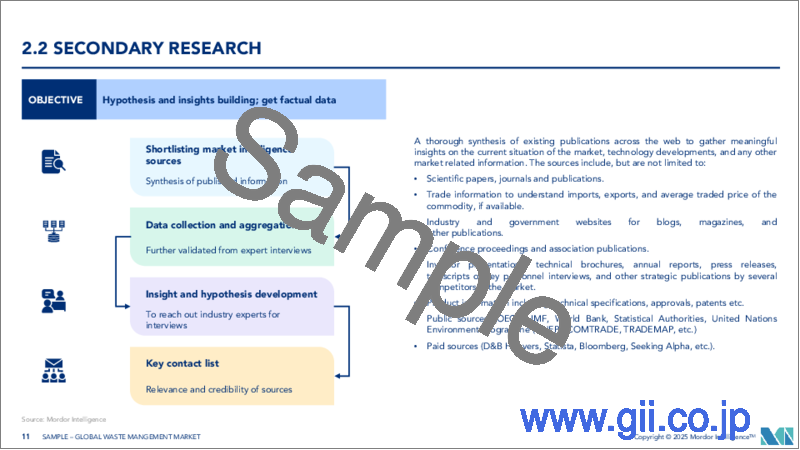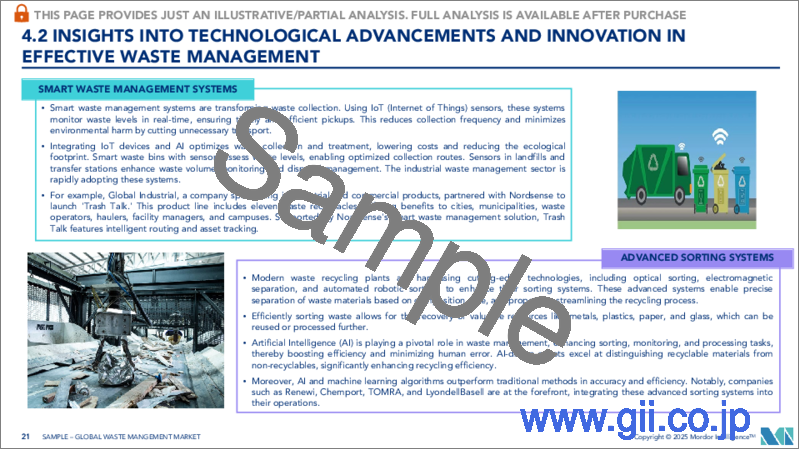|
|
市場調査レポート
商品コード
1642115
世界の廃棄物管理-市場シェア分析、産業動向・統計、成長予測(2025年~2030年)Global Waste Management - Market Share Analysis, Industry Trends & Statistics, Growth Forecasts (2025 - 2030) |
||||||
カスタマイズ可能
適宜更新あり
|
|||||||
| 世界の廃棄物管理-市場シェア分析、産業動向・統計、成長予測(2025年~2030年) |
|
出版日: 2025年01月05日
発行: Mordor Intelligence
ページ情報: 英文 160 Pages
納期: 2~3営業日
|
- 全表示
- 概要
- 目次
世界の廃棄物管理市場規模は2025年に5,235億3,000万米ドルと推定され、予測期間中(2025~2030年)のCAGRは4.55%を超え、2030年には6,539億8,000万米ドルに達すると予測されています。

廃棄物管理市場の成長にはいくつかの重要な要因があります。まず、廃棄物の発生量が増加しており、都市化と人口増加の増大に対応するために効果的な廃棄物管理システムが必要とされています。固形廃棄物の発生量の増加は、消費パターンと都市生活様式の増加によるもので、効率的な管理のための革新的な解決策を見出す必要があります。
第二に、環境保護と持続可能性の必要性に対する意識の高まりから、適切な廃棄物管理の実践に対する需要が高まっています。消費者、産業、政府は、環境フットプリントを削減するために廃棄物を減らし、リサイクルや循環型経済のアプローチを採用することの重要性を認識しています。
世界では毎年20億トン以上の都市固形廃棄物が発生しており、この数字は2050年まで約70%増加すると予測されています。2022年には、1日あたり1万トン以上の廃棄物が、世界で最も巨大な埋立地に運ばれました。また、特に新興国では、廃棄物が危険な閉鎖型埋立地に頻繁に投棄されています。リサイクル率が国によって大きく異なることを考えると、改善と開発の余地はまだまだ大きいです。
さらに、インド、中国、台湾のような新興諸国では、膨大な量の廃棄物を排出し、汚染を引き起こす化学、石油・ガス、自動車、医療セグメントの開発が工業生産の増加の原因となっています。
廃棄物管理市場の動向
E廃棄物セグメントが最大のシェアを占める
開発、イントロダクション、成長、成熟、廃棄またはリサイクルは、すべて電子製品の日常的なライフサイクルの一部です。電子製品がリサイクルの段階に達するのは、耐用年数の終了、技術の進歩、市場の需要の変化などが原因です。ノートパソコン、携帯電話、テレビなど、すでにある製品の新しい電子機器や改良型は、技術の急速な向上の結果として生産されています。
鉄、銅、錫、アルミニウムは、電子廃棄物に含まれる主要金属であり、その重量の90%以上を占めます。しかし、最も価値の高い金属はパラジウムで、ミネソタ州で年間15億米ドル以上、プラチナは推定10億米ドル以上、銅とスズはそれぞれ推定1億米ドル以上です。
一人当たりで見ると、欧州人(16.2Kg)が最も多く、オセアニア(16.1Kg)、南北アメリカ(13.3Kg)と続きます。アフリカの住民は、一人当たりの電子機器廃棄物の量が最も少ないです。
インドは現在、米国、中国に次ぐ世界第3位の電子廃棄物排出国であり、その量は着実に増加しています。インドでは、コンピューター機器が電子廃棄物の70%近くを占め、次いで携帯電話が12%、電化製品が8%、医療機器が7%となっています。
地域によって異なるが、世界的に見ると、廃棄物の1%以下しかリサイクルされていないです。世界の電子機器廃棄物全体のうち、回収され、適切にリサイクルされているのはわずか17.4%であることが知られています。欧州の回収・リサイクル率は42.5%で圧倒的に高いです。2位はアジアで11.7%。アフリカはわずか0.9%で、世界で最も低いです。
古くなったデバイスを新しいデバイスに交換する需要を促進する先進的な電子・電気デバイスの導入が増加しているため、北米とアジアでは約2,490万トンの電子廃棄物が発生しています。
アジア太平洋が最も重要な世界廃棄物管理市場に浮上
Swacch Bharat Abhiyanやアジア太平洋諸国が採用している廃棄物ゼロ計画のような政府の取り組みにより、廃棄物管理に対する意識が高まると予測されています。これは、アジア太平洋の市場拡大に好影響を与えると考えられます。
中国は2022年の世界のプラスチック材料生産の32%を占め、世界最大の生産国となっています。他のアジア諸国も重要なプラスチック生産国であり、日本の生産量は世界のプラスチック生産量の3%に達し、その他のアジア諸国は世界のプラスチック生産量の17%を生産しています。
この地域の主要新興国における急速な工業化と、環境保護に向けた政府の厳しい規制が、アジア太平洋廃棄物管理市場の成長を後押しすると予想されます。日本の改正廃棄物処理法では、廃棄物を発生させる事業所以外に廃棄物を保管する場合、その場所やその他の廃棄物データを記録することを企業の所有者に義務付けています。同改正はまた、元の建築請負業者にも適切な廃棄物処理の責任を求めています。
例えば2022年、国連環境総会はプラスチック汚染を終わらせる決議を支持し、2024年末までに法的拘束力のある国際的な合意を実施することで合意しました。Ellen MacArthur Foundation「Global Commitment」には、プラスチック包装市場の20%以上を占める署名企業が名を連ねており、その中にはCoca-Cola CompanyやPepsiCoなどの企業も含まれています。これらの企業は、プラスチック廃棄物を削減し、循環型経済への移行を進展させるための野心的な2025年目標を設定しています。
中国は2021年にプラスチック汚染削減のための5カ年行動計画を発表し、スーパーマーケットやショッピングモール、主要都市、食品宅配サービスでの非分解性プラスチック袋の使用禁止を盛り込みました日本は、「幅広い利害関係者の間で循環経済への理解をさらに深めることを目的に、官民のパートナーシップを強化することを目的とした」日本循環経済パートナーシップ(J4CE)を前年に設立したのに続き、2022年にプラスチック資源循環法を制定しました。
廃棄物管理産業概要
世界の廃棄物管理市場は競争が激しく、世界中のさまざまな産業や家庭で発生する廃棄物をリサイクル・再利用する革新的な技術に注力する企業が多いです。また、ゼロ廃棄物-3R(リデュース、リユース、リサイクル)哲学に従って廃棄物削減に継続的に注力している新興企業もいくつか登場しています。
その他の特典
- エクセル形式の市場予測(ME)シート
- 3ヶ月間のアナリストサポート
目次
第1章 イントロダクション
- 調査の前提条件と市場定義
- 調査範囲
第2章 調査手法
第3章 エグゼクティブサマリー
第4章 市場洞察と市場力学
- 市場概要
- 効果的な廃棄物管理における技術の進歩と革新に関する洞察
- バリューチェーン/サプライチェーン分析
- 世界の廃棄物管理産業に参入する新興企業の戦略に関する洞察
- 市場動向に関するスポットライト
- COVID-19が市場に与える影響
第5章 市場力学
- 市場促進要因
- 都市人口の増加
- 廃棄物発生量の増加
- 市場抑制要因
- 新興諸国における認識不足
- 市場機会
- 新興国における高い成長の可能性
- ポーターのファイブフォース分析
- 新規参入業者の脅威
- 買い手・消費者の交渉力
- 供給企業の交渉力
- 代替品の脅威
- 競争企業間の敵対関係の強さ
第6章 市場セグメンテーション
- 廃棄物タイプ別
- 産業廃棄物
- 都市固形廃棄物
- 電子廃棄物
- プラスチック廃棄物
- 医療廃棄物とその他の廃棄物
- 処分方法別
- 埋立処分
- 焼却
- リサイクル
- 地域別
- 北米
- 米国
- カナダ
- メキシコ
- 欧州
- 英国
- ドイツ
- フランス
- ロシア
- その他の欧州
- アジア太平洋
- 中国
- 日本
- インド
- 韓国
- その他のアジア太平洋
- 中東・アフリカ
- 南アフリカ
- サウジアラビア
- カタール
- その他の中東・アフリカ
- ラテンアメリカ
- ブラジル
- アルゼンチン
- その他のラテンアメリカ
- 北米
第7章 競合情勢
- 企業プロファイル
- Biffa Group
- Clean Harbors, Inc.
- Covanta Holding Corporation
- Veolia Environment SA
- Waste Connections
- Remondis AG & Co. Kg
- Suez Environment S.A.
- Daiseki Co. Ltd
- Waste Management Inc.
- Republic Services
- Averda*
- その他の企業
第8章 市場機会と今後の動向
第9章 付録
The Global Waste Management Market size is estimated at USD 523.53 billion in 2025, and is expected to reach USD 653.98 billion by 2030, at a CAGR of greater than 4.55% during the forecast period (2025-2030).

Several key factors have led to the growth of the waste management market. First, the volume of waste produced has increased, and an effective waste management system is needed to cope with growing urbanization and population growth. The increased production of solid waste is due to the increase in consumption patterns and urban lifestyles, which makes it necessary to find innovative solutions for its efficient management.
Second, there has been an increased demand for good waste management practices due to growing awareness about the need to protect the environment and sustainability. Consumers, industry, and governments recognize the importance of reducing waste and adopting recycling and circular economy approaches to reduce their environmental footprint.
Over 2 billion tonnes of municipal solid waste are produced worldwide every year, and this figure is projected to grow by approximately 70 % until 2050. Over 10,000 tonnes of waste per day were transported to the world's most giant landfills in 2022. In addition, especially in emerging countries, waste is frequently dumped at dangerous closed landfills. There is still much room for improvement and development, given that recycling rates vary widely from country to country.
Furthermore, the development of chemical, oil & gas, automotive, and medical sectors that produce vast amounts of waste and cause pollution is due to increased industrial production in developing countries like India, China or Taiwan.
Waste Management Market Trends
E-waste segment holds the largest share
Development, introduction, growth, maturation, and disposal or recycling are all parts of the everyday life cycle of an electronic product. When an electronic product reaches the recycling stage, it may be because of the end of its useful life, technological advancements, or shifting market demands. New electronic devices and improved models of already-existing products, such as laptops, mobile phones, and televisions, are produced as a result of the rapid improvements in technology.
Iron, copper, tin, and aluminum are the primary metals in e-waste, accounting for more than 90 % of its weight. But the metals with the highest value are palladium, over an estimated USD 1.5 billion in e-waste produced annually in Minnesota; platinum, over an estimated USD 1 billion; copper, and tin, over an estimated USD 100 million each.
When measured per capita, Europeans (16.2 Kg) produce the most e-waste per person, followed by Oceania (16.1 Kg) and the Americas (13.3 Kg). African residents have the least amount of e-waste per capita.
India is now the world's third largest electronic waste producer after the US and China, with steadily increasing volume growth. In India, computer equipment represents nearly 70% of e-waste, followed by cell phones at 12%, electric appliances at 8%, and healthcare devices at 7%.
Globally, less than 1 % of waste is recycled, although this varies from region to region. It is known that only 17.4% of total global e-waste is collected and properly recycled. The rate of collection and recycling in Europe is by far the highest in the world at 42.5%. In second place, Asia had a rate of 11.7%. At just 0.9%, Africa is the lowest in the world.
Due to the increasing adoption of Advanced Electronic and Electrical Devices, which drive demand for replacing obsolete devices with new ones, North America and Asia accounted for approximately 24.9 million tonnes of e-waste.
Asia Pacific Emerged as the Most Significant Global Waste Management Market
Awareness about waste management is projected to increase due to government initiatives like the Swacch Bharat Abhiyan and the zero waste plans adopted by various Asia Pacific nations. This will have a favorable effect on expanding the market in the Asia Pacific.
China accounted for 32 percent of global plastic materials production in 2022, making it the world's largest producer. Other Asian countries were also significant plastic manufacturers, with Japan's production amounting to 3% of the global plastic production and the rest of Asia producing 17% of the world's plastic.
Rapid industrialization in major emerging economies in the region and stringent government regulations towards environmental protection are expected to boost the growth of the Asia-Pacific waste management market. The amended Waste Disposal and Cleaning Law of Japan requires company owners to record the location and other waste data when such items are stored outside of the business sites that generate them. The amendment also holds the original building contractors accountable for proper waste disposal.
In 2022, for example, the United Nations Environment Assembly endorsed a resolution to end plastic pollution and agreed to implement an international, legally binding agreement by the end of 2024. The Ellen MacArthur Foundation's Global Commitment has signatories accounting for more than 20% of the plastic packaging market, including companies such as The Coca-Cola Company and PepsiCo, who have set ambitious 2025 targets to reduce plastic waste and progress the move to a circular economy.
China announced its five-year action plan for reducing plastic pollution in 2021, including bans on non-degradable plastic bags in supermarkets and shopping malls, major cities, and food delivery services. Japan enacted its Plastic Resource Circulation Act in 2022, following the founding of the Japan Partnership for Circular Economy (J4CE) the year before "for the purpose of strengthening public and private partnerships, with the aim of further fostering understanding of the circular economy among a wide range of stakeholders."
Waste Management Industry Overview
The global waste management market is highly competitive, with many players focused on innovative technologies to recycle and reuse the waste generated across various industries and households across the globe. There are also several startups coming up in the industry that are continuously focusing on waste reduction following the Zero Waste - 3R (Reduce, Reuse, and Recycle) philosophy.
Additional Benefits:
- The market estimate (ME) sheet in Excel format
- 3 months of analyst support
TABLE OF CONTENTS
1 INTRODUCTION
- 1.1 Study Assumptions and Market Definition
- 1.2 Scope of the Study
2 RESEARCH METHODOLOGY
3 EXECUTIVE SUMMARY
4 MARKET INSIGHTS and DYNAMICS
- 4.1 Market Overview
- 4.2 Insights into Technological Advancements and Innovation in Effective Waste Management
- 4.3 Value Chain/Supply Chain Analysis
- 4.4 Insights on Strategies of Rising Startups Venturing into the Global Waste Management Industry
- 4.5 Spotlight on Market Trends
- 4.6 Impact of COVID-19 on the Market
5 MARKET DYNAMICS
- 5.1 Market Drivers
- 5.1.1 Growth in urban population
- 5.1.2 Increase in amount of waste generation
- 5.2 Market Restraints
- 5.2.1 Lack of awareness in developing countries
- 5.3 Market Opportunities
- 5.3.1 High growth potential in emerging economies
- 5.4 Porter's Five Forces Analysis
- 5.4.1 Threat of New Entrants
- 5.4.2 Bargaining Power of Buyers/Consumers
- 5.4.3 Bargaining Power of Suppliers
- 5.4.4 Threat of Substitute Products
- 5.4.5 Intensity of Competitive Rivalry
6 MARKET SEGMENTATION
- 6.1 By Waste type
- 6.1.1 Industrial waste
- 6.1.2 Municipal solid waste
- 6.1.3 E-waste
- 6.1.4 Plastic waste
- 6.1.5 Biomedical and Other Waste Types
- 6.2 By Disposal methods
- 6.2.1 Landfill
- 6.2.2 Incineration
- 6.2.3 Recycling
- 6.3 Geography
- 6.3.1 North America
- 6.3.1.1 United States
- 6.3.1.2 Canada
- 6.3.1.3 Mexico
- 6.3.2 Europe
- 6.3.2.1 United Kingdom
- 6.3.2.2 Germany
- 6.3.2.3 France
- 6.3.2.4 Russia
- 6.3.2.5 Rest of Europe
- 6.3.3 Asia-Pacific
- 6.3.3.1 China
- 6.3.3.2 Japan
- 6.3.3.3 India
- 6.3.3.4 South Korea
- 6.3.3.5 Rest of Asia-Pacific
- 6.3.4 Middle East & Africa
- 6.3.4.1 South Africa
- 6.3.4.2 Saudi Arabia
- 6.3.4.3 Qatar
- 6.3.4.4 Rest of Middle East and Africa
- 6.3.5 Latin America
- 6.3.5.1 Brazil
- 6.3.5.2 Argentina
- 6.3.5.3 Rest of Latin America
- 6.3.1 North America
7 COMPETITIVE LANDSCAPE
- 7.1 Overview (Market Concentration and Major Players)
- 7.2 Company Profiles
- 7.2.1 Biffa Group
- 7.2.2 Clean Harbors, Inc.
- 7.2.3 Covanta Holding Corporation
- 7.2.4 Veolia Environment SA
- 7.2.5 Waste Connections
- 7.2.6 Remondis AG & Co. Kg
- 7.2.7 Suez Environment S.A.
- 7.2.8 Daiseki Co. Ltd
- 7.2.9 Waste Management Inc.
- 7.2.10 Republic Services
- 7.2.11 Averda*
- 7.3 Other Companies






